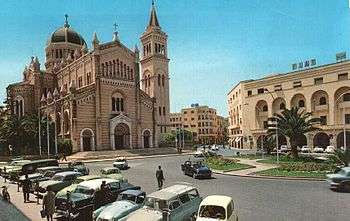Roman Catholicism in Libya



The Roman Catholic Church in Libya is part of the worldwide Catholic Church, under the spiritual leadership of the Pope in Rome.
Characteristics
There are around 50,000 Catholics in Libya, comprising less than one percent of the population. Among the Catholics are Italian Libyans and Maltese Libyans. Thousands of Filipino Catholic nurses moved to Libya during the 1980s and 1990s. The Italians were the majority of the Catholics in Libya until their expulsion in 1969 by Colonel Gaddafi.
There are no dioceses in Libya, but there are four territorial jurisdictions - three Apostolic Administrations and one Apostolic Prefecture.
- Apostolic Vicariate of Benghazi
- Apostolic Vicariate of Derna
- Apostolic Vicariate of Tripoli
- Apostolic Prefecture of Misrata
History
Christianity has been present in Libya since Roman times. Saint Francis of Assisi brought his faith to Tripoli in the Middle Ages.
The Church of Santa Maria degli Angeli (Our Lady of the Angels) in the Old City - Medina of Tripoli was founded in 1645 and, with the permission of the Sultan of Constantinople, the Church of the Immaculate Conception was founded in Benghazi in 1858.
Before World War II the number of Catholics increased in Libya due to its status as an Italian colony, but the Catholic Cathedral of Tripoli (built in the 1920s) was converted to a mosque.[1] The other Catholic cathedral in Libya, the Benghazi Cathedral is under reconstruction and probably will reopen as a museum.
Current
There are currently two Catholic churches in Libya, the Church of San Francesco in Tripoli and the Maria Immacolata Parish Church in Benghazi, both of which are led by Franciscan priests from the Province of St. Paul the Apostle (Malta).[2] Each church is made up of "personal parishes" based on language, with each personal parish assigned its own priest.
Notes
- ↑ Photos of Libyan catholic churches (in Italian)
- ↑ "The Catholic Church in Libya". Franciscan Province of St. Paul the Apostle (Malta). Order of Friars Minor - St. Paul the Apostle Province.
See also
External links
| ||||||||||||||